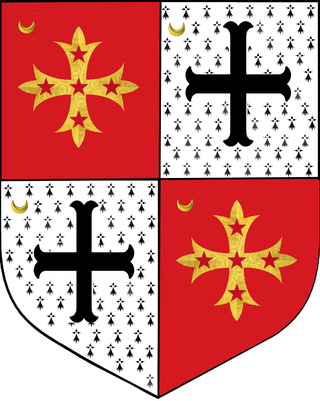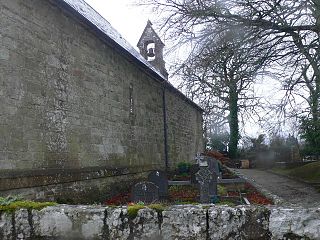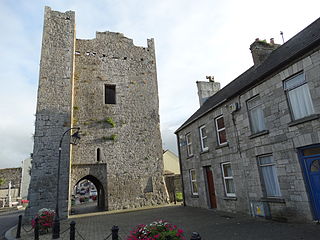
Bunratty Castle is a large 15th-century tower house in County Clare, Ireland. It is located in the centre of Bunratty village, by the N18 road between Limerick and Ennis, near Shannon Town and its airport. The castle and the adjoining folk park are run by Shannon Heritage as tourist attractions.

Cornelius Bernard Colbert was an Irish rebel and pioneer of Fianna Éireann. For his part in the Easter Rising of 1916, he was shot by firing squad in Kilmainham Gaol, Dublin, on 8 May 1916.

Newcastle West or simply Newcastle is a town in west County Limerick, Ireland. It is the largest town in the county, excluding Limerick city. It is also the county town, and sits on the River Arra which flows into the River Deel. Newcastle West is in the middle of a great bowl-shaped valley in West Limerick, known one time as the valley of the Wild Boar, apparently due to the abundance of this animal here when the area was thickly wooded. The crest of the town carries the image of a wild boar. The town is partly in the civil parish of Newcastle.

A watchtower or watch tower is a type of fortification used in many parts of the world. It differs from a regular tower in that its primary use is military and from a turret in that it is usually a freestanding structure. Its main purpose is to provide a high, safe place from which a sentinel or guard may observe the surrounding area. In some cases, non-military towers, such as religious towers, may also be used as watchtowers.

Ballingarry is a village in County Limerick, Ireland. It is located near the village of Granagh and between the towns of Rathkeale and Kilmallock on the R518 road. Ballingarry lies in a civil parish of the same name, and within the ecclesiastical parish of Ballingarry-Granagh in the Roman Catholic Diocese of Limerick. The village had a population of 570 as of the 2022 census, up from 521 at the 2016 census.
Events from the year 1462 in Ireland.
Killeedy is a civil parish located south of Newcastle West in Co. Limerick in Ireland. This parish consists of two villages, Ashford and Raheenagh. The elevation of the parish varies from 1,184 ft. OS at Mauricetown and 1,082 ft. at Dromdeeveen to 200 ft. OS at Ballintubber. The parish is overlooked by the Mullaghareirk Mountains. The patron saint of Killeedy is Saint Ita. Killeedy used to be known as Cluain Chreadhail but in later ages it had taken the name of Cill íde, the Church of Saint Ita, from a nunnery which was founded there in the sixth century. On 15 January of each year, the feast of St. Ita's Day is celebrated in Killeedy.

Sir Henry Ughtred or Oughtred was a merchant and shipbuilder during the reign of Elizabeth I. One of his ships, the Leicester sailed with Sir Francis Drake against the Spanish Armada. He was elected MP for the seat of Marlborough in 1584 and of Great Bedwyn in 1589. A wealthy landowner, Ughtred played an active role in the Plantations of Ireland and was knighted by the Lord Deputy in 1593. He was the son of Sir Anthony Ughtred and Elizabeth Seymour, sister to Jane, the third wife of Henry VIII. Sometime after 1557 he married Elizabeth, widow of Sir William Courtenay and daughter of John Paulet, 2nd Marquess of Winchester.

St. Cronan's Church is a 10th-century Church of Ireland church in Tuamgraney, County Clare, Ireland. It is the oldest church in continuous use in Ireland. The Tuamgraney parish operates as a unit with the Mountshannon parish in the Killaloe Union of parishes in the Diocese of Tuam, Limerick and Killaloe.

Johnstown Castle is a Gothic Revival castle located in County Wexford, Ireland.
The Corca Oíche, meaning "the race of Oíche", was an ancient tribe, possibly of Pictish origin, existing since pre-Christian times in Ireland. It is possible that they descend from the Cruthin, a people whose territory existed near Lough Neagh in north-east Ireland. As such, some sources claim that they descended from the semi-legendary hero Dubthach Dóeltenga, or more commonly that they are descended from Oíche or Óchae, the daughter of Cronn Badhraoi of the Dál nAraidi, and her son Fergus Foga last king of the Ulaid to rule at Emain Macha.

Burncourt Castle is a fortified house and a National Monument in County Tipperary, Ireland.

Fanning's Castle, also called Whitamore's Castle, is the remains of a tower house and National Monument located in Limerick, Ireland.

Ballymalis Castle is a tower house and National Monument located in County Kerry, Ireland.

King John's Castle or King's Castle is a tower house and National Monument located in Kilmallock, Ireland.

Ardamullivan Castle is a tower house and National Monument located in County Galway, Ireland.

Desmond Hall and Castle, also called Desmond Castle and Banqueting Hall or Newcastle West Medieval Complex and Desmond Hall, are a set of medieval buildings and National Monuments located in Newcastle West, Ireland. For over 200 years, it belonged to the Fitzgerald family, Earls of Desmond.

Oola Castle is a tower house located in County Limerick, Ireland.
Sir George Oughtred Courtenay, 1st Baronet, of Newcastle was an Irish landowner and soldier. He defended Limerick at the siege of 1642 during the Irish Rebellion of 1641.
















